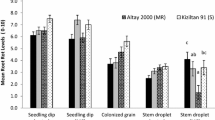Abstract
Inoculation methods were developed for the purpose of screening a large collection of mungbean germplasm lines for resistance to tan spot caused by Curtobacteriumflaccumfaciens pv. flaccumfaczens. Stem prick and leaf infiltration inoculations were used to induce symptoms of vascular wilt and leaf scorch, respectively. There was variation in reaction to the two different tests within a range of eight cultivars tested. Cv. Green Diamond showed tolerance in both tests. However, there was little correlation between the two tests in disease reaction. Evidence indicates that the leaf scorch symptom is also due to water deprivation rather than to apoplastic pathogen invasion. A stem prick test suitable for screening mungbeans for tolerance to tan spot is described.
Similar content being viewed by others
References
Agrios, G.N. (1980) —Escape from disease. In Plant Disease: An Advanced Treatise (Eds J.G. Horsfall and E.B. Cowling), pp. 17–37. Academic Press, New York.
Condé, B.D. and Diatloff, A. (1991) — Diseases in mungbean. In Mungbean: The Australian Experience. Proceedings of the first Australian mungbean workshop (Eds B.C. Imrie and R.J. Lawn), pp. 73–77. CSIRO Division of Tropical Crops and Pastures, Brisbane.
Diatloff, A,, Wong, W.C. and Wood, B.A. (1993) — Nondestructive methods of detecting Curtobacterium flaccumfaciens pv. flaccumfaciens in mungbean seeds. Letters in Applied Microbiology 16: 269–273.
Diatloff, A, and Imrie, B.C. (1999) — Evaluating tan spot resistance in mungbean accessions. In Proceedings of the 11th Australian Plant Breeding Conference 2: 186. Adelaide, April 1999.
Duniway, J.M. (1973) — Pathogen-induced changes in host water relations. Phytopathology 63: 458–466.
Fahy, P.C. and Hayward, A.C. (1983) — Media and methods for isolation and diagnostic tests. In Plant Bactevial Diseases, a Diagnostic Guide. (Eds P.C. Fahy and G.J. Persley), pp. 337–378. Academic Press Australia, North Ryde.
Gasson, M.J. (1980) — Indicator technique for antimetabolic toxin production by phytopathogenic species of Pseudomonas. Applied and Envivonmental Microbiology 39: 25–29.
Hagborg, W.A.F. (1970) — A device for injecting solutions and suspensions into thin leaves of plants. Canadian Journal of Botany 48: 1135–1136.
Harris-Baldwin, A. and Gudmestad, N.C. (1996) — Identification of phytopathogenic coryneform bacteria using the Biolog automated microbial identification system. Plant Disease 80: 874–878.
Hayward, A.C. and Waterston, J.M. (1965) — Corynebacterium flaccumfaciens. CMI Descriptions of Pathogenic Fungi and Bacteria, No 43, Commonwealth Mycological Institute, Kew, UK.
Lelliott, R.A. and Stead, D.E. (1987) — Methods for the diagnosis of bacterial diseases of plants. In Methods in Plant Pathology Vol. 2 (Ed T.F. Preece), pp. 80–102. Blackwell Scientific Publications, Oxford.
Lenné, J.M. (1994) — Disease of other pasture legumes. In Diseases of Tropical Pasture Plants (Eds J.M. Lenné and P. Trutmann), pp. 129–157. CAB International, Wallingford, UK.
Miles, A.A. and Misra, S.S. (1938) — The estimation of the bactericidal power of the blood. Journal of Hygiene Cambridge 38: 732–737.
Schuster, M.L. and Coyne, D.P. (1981) — Biology, epidemiology, genetics and breeding for resistance to bacterial pathogens of Phaseolus vulgaris L. Horticultural Reviews 3: 28–58.
Schuster, M.L. and Sayre R.M. (1967) — A Coryneform bacteria induces purple-coloured seed and leaf hypertrophy of Phaseolus vulgavis and other Leguminosae. Phytopathology 57: 1064–1066.
Wood, B.A. and Easdown, W.J. (1990) — A new bacterial disease of mungbean and cowpea for Australia. Australasian Plant Pathology 19: 16–21.
Author information
Authors and Affiliations
Corresponding author
Rights and permissions
About this article
Cite this article
Diatloff, A., Imrie, B.C. Inoculation techniques for evaluating resistance to Curtobacterium flaccumfaciens pv. flaccumfaciens in mungbean cultivars . Australasian Plant Pathology 29, 24–28 (2000). https://doi.org/10.1071/AP00004
Received:
Accepted:
Issue Date:
DOI: https://doi.org/10.1071/AP00004




